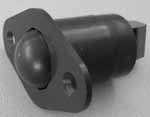Built In EOL's
An End-Of-Line resistor supervises the wiring between the alarm panel and the switch. Some panels have a limited number of detection zones and do not require EOL resistors. But if the panel can use EOL resistors to supervise the wiring, the resistors should be used. If more than one detection device is on a single detection circuit, the EOL should be at the last device. When feasible, every alarm detection device should have an EOL resistor at the device. If the EOL resistor is at the burglary contact on a door, the panel sees the wire open when the door is opened and sees the resistor when the door is closed. The thief who shorts wires together hides the EOL resistor from the panel, letting the panel know that something is going on. The thief who cuts the wire causes an open circuit, the same as if he had opened the door. Hold-up alarms and Fire alarms use an "open circuit" detection scheme. The panel normally sees the EOL resistor at the end of the detection circuit. A short on the wire causes an alarm and a break in the wire causes a trouble report. Since normally closed switches can weld due to high voltage like lightning, the normally closed switches used for burglary detection must be checked after severe weather to see that they still work properly. Since devices on a "open circuit" normally cannot weld open, lightning and power surges should not "weld" these switches into an inoperable state. Some security systems even use this high security mode for their burglary devices.
Where should EOL resistors be installed?
What makes EOL resistors so important is that they can supervise the wires only when they are at the end of the line. When properly placed in the circuit, EOL resistors prevent wire tampering on normal switches. EOL resistors in the control panel are usually ineffective. The usual net effect of putting the EOL resistors in the panel is that the panel acts as if it has no EOL resistors. Even open circuit devices like smoke detectors and hold-up buttons are not properly supervised when the EOL resistor is attached in the panel before the end of the line. Many companies install the EOL resistors in the panel or use panels that do not supervise the wiring. Some alarm manufacturers show the EOL connected at the panel. The proper placement of an EOL resistor is at the End-Of-Line, the last switch on the detection circuit. EOL resistors do not belong at the panel. Keep in mind when ordering, only one contact is required at the end of the line. In other words if you have a zone with five door contacts you would use for regular contacts (NO EOL) and one EOL contacts at the end.
Displaying 1 to 6 (of 16 Products)
| Product Name- | Price | |
|---|---|---|
 |
GRI PBF-100TW1K Contact with Built In 1K EOL White Bag of 10Special Order Sold in Quantities of 10 Only PBF 3/4" x 1 1/2" Fits 3/4" Hole Built in 1K Resistor N.C Loop White UL and ULC Approved |
$119.50Buy Now |
 |
GRI PBF-100TB1K Contact with Built In 1K EOL Brown Bag of 10Special Order Sold in Quantities of 10 Only PBF 3/4" x 1 1/2" Fits 3/4" Hole Built in 1K Resistor N.C Loop Brown UL and ULC Approved |
$119.50Buy Now |
 |
GRI PBF-100TW2K Contact with Built In 2K EOL White Bag of 10Special Order Sold in Quantities of 10 Only PBF 3/4" x 1 1/2" Fits 3/4" Hole Built in 2K Resistor N.C Loop White UL and ULC Approved |
$119.50Buy Now |
 |
GRI PBF-100TB2K Contact with Built In 2K EOL Brown Bag of 10Special Order Sold in Quantities of 10 Only PBF 3/4" x 1 1/2" Fits 3/4" Hole Built in 2K Resistor N.C Loop Brown UL and ULC Approved |
$119.50Buy Now |
 |
GRI DS-01TW1K Roller Ball w/ Built In 1K EOL White Bag of 10Special Order Sold in Quantities of 10 Only |
$119.50Buy Now |
 |
GRI DS-01TB1K Roller Ball w/ Built In 1K EOL Brown Bag of 10Special Order Sold in Quantities of 10 Only Roller Ball with built in End of Line Resistor 1K Brown |
$119.50Buy Now |
Displaying 1 to 6 (of 16 Products)
Parse Time: n/a - Number of Queries: 110 - Query Time: 0